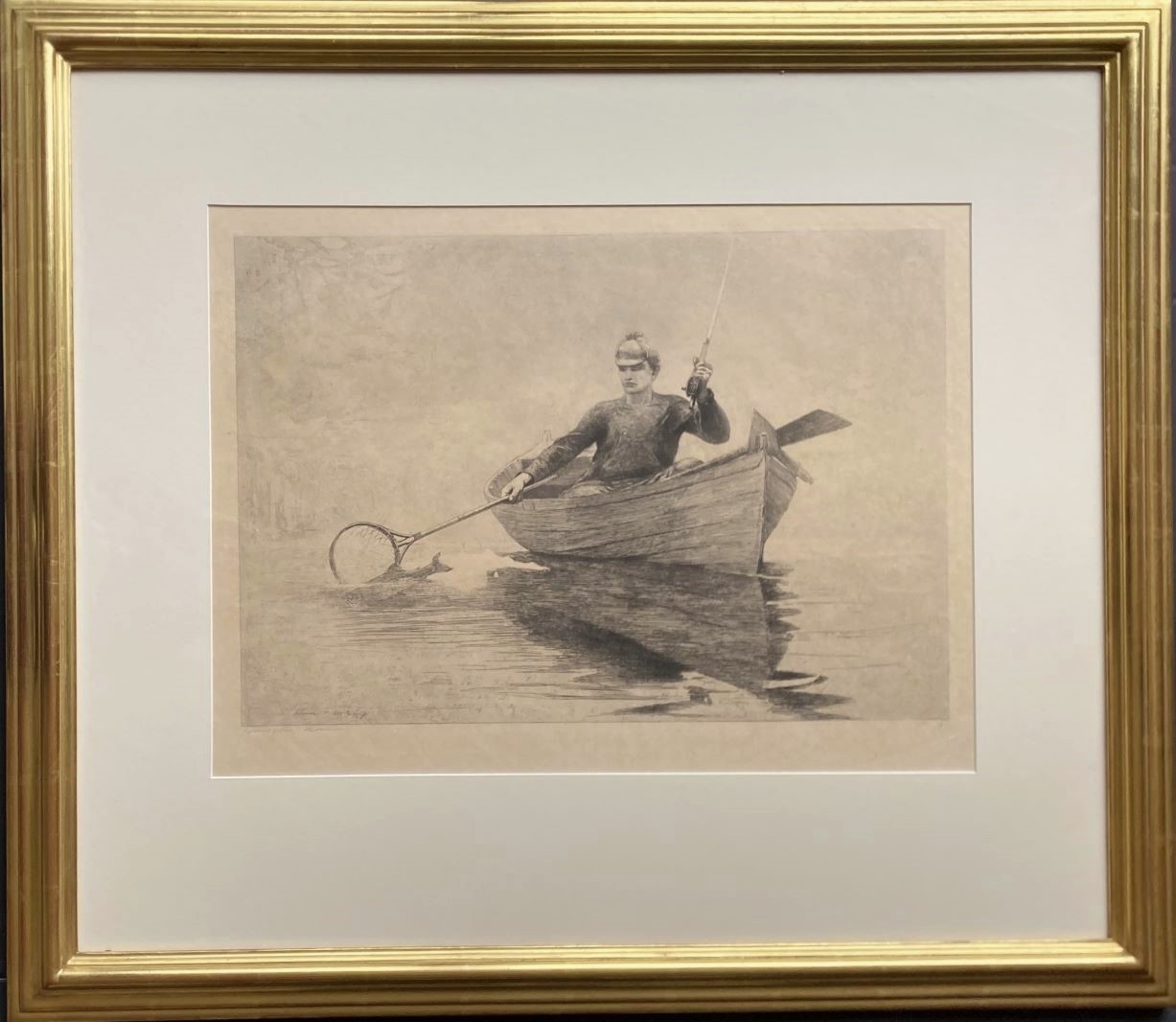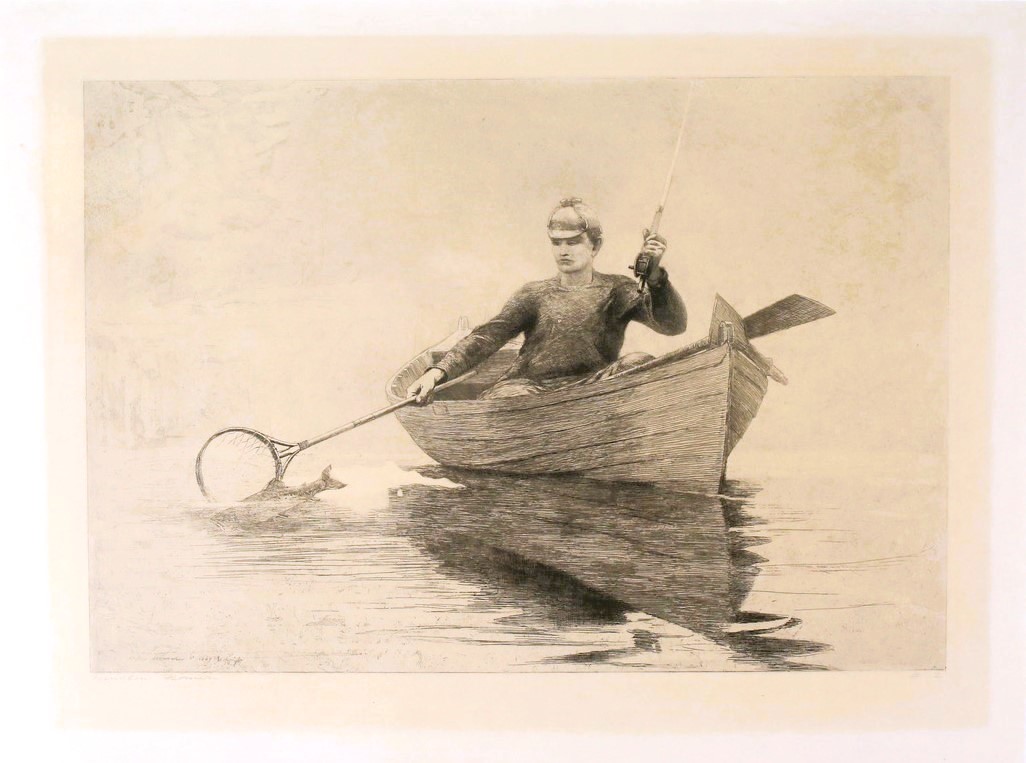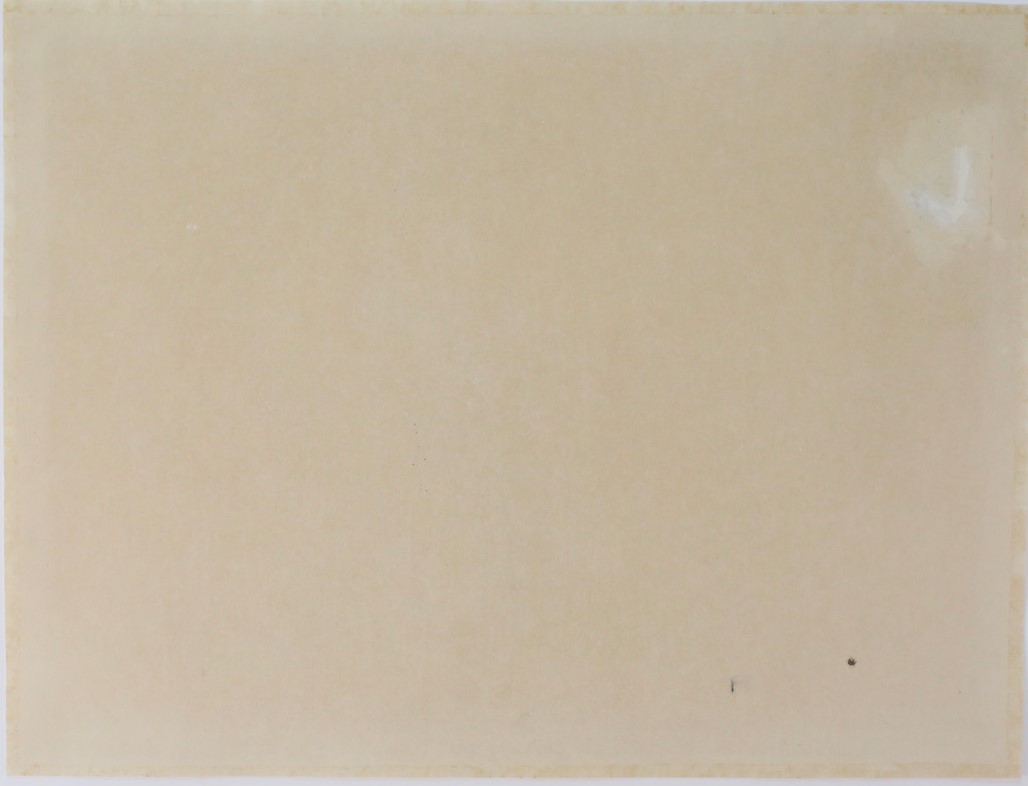![]()
Winslow Homer. 1836-1910.



Fly Fishing, Saranac Lake. 1889. Etching, aquatint and burnishing. Goodrich 104. 14 1/4 x 20 5/8; sheet 18 1/2 x 24 1/2. Edition unknown but quite possibly intended 100; highest numbered impression known is 62. A rich impression with subtle plate tone printed on simili-Japan paper. The image is toned; the sheet has been professionally cleaned, and a small tear in the upper left-hand quadrant has been repaired. Signed and dated in the plate, lower left 'Winslow Homer Sc 1889'. Signed in pencil, "Winslow Homer' lower left; numbered '2/100' in pencil, lower right. Housed in a 29 x 33 1/2 gold leaf frame. $50,000.
Fly Fishing, Saranac Lake is the only composition which the artist created exclusively as a print, not after one of his paintings; it is also probably his last etching. It is perhaps the most highly sought after of the Homer etchings. Lifetime impressions of Fly Fishing, Saranac Lake are extremely rare.
The printing of Homer's lifetime impressions was handled by George W.H. Ritchie who at first also attempted, with limited success, to sell the prints; later the print dealer C. Klackner handled the sales. Around 1900 the five plates in Ritchie's possession were put in storage and no more prints were made from them until about 1940, when Charles S. White, who had bought the business from Ritchie, began to make posthumous prints. The plates were bought by William M. Ivins, Curator of Prints at the Metropolitan Museum, who asked White to print additional impressions of the plates but to wipe the plates clean to achieve a more linear quality. The impressions printed by White in 1940 more closely resemble this impression with tone to add form that was typical of etchings produced in the late nineteenth century. The prints printed in 1940 and 1941 are often called the 'White' impressions and are generally printed on Japan paper.
The signed prints are printed with rich plate tone in the figure and central areas, and the plate tone has been selectively wiped in other areas, resulting in a strong contrast between the central figures and the surrounding areas. The posthumous impression has much plate tone overall but no differentiation between the central area and the rest of the print. Thus, the central figure is printed rather dryly in the posthumous printing relative to the lifetime impressions. This is consistent with Goodrich’s discussion of the lifetime and posthumous printings (p. 19, Lloyd Goodrich, The Graphic Art of Winslow Homer; he inexplicably prefers the flat later printing, referring to the earlier printing as “romantic”!).
There are many other differences as well. For example, the white area to the right of the fish was apparently burnished by Homer, to eliminate a number of lines and hazy shading; in the lifetime impressions the effect is a clear white as intended, but in the posthumous impression the use of heavy plate tone picked up some of these lines and hazy shading, thus defeating the desired burnished effect.
The top right corner of the posthumous impression shows some blotching and spotting resulting from the corrosion of the plate; this area is evident on the plate itself. The lifetime impressions, made prior to this corrosion, show no such effects.
![]()
Lloyd Goodrich writes, in his catalogue of Homer's etchings, The Graphic Art of Wislow Homer (New York: The Museum of Graphic Art, 1958): " Homer's etchings were constructed primarily in pure line, the forms being built by linear modelling, the darks secured by linework rather than tonal printing. The devices of printing that the new school of etchers was exploiting had little place in his work, which belonged to an older tradition, akin to engraving. Compare to the subtleties and refinements of the new men, his style was severe and hard. But no other American etcher of the period displayed his structural strength, his mastery of the human figure, and his completeness of design.
Unlike Whistler, Homer's technique was line-based (an influence from his illustration background) and he did not rely on inking and selective wiping to achieve tonal quality. Homer etched 8 plates between 1884 and 1889, all were based on his popular marine paintings. He abandoned etching around 1889, partly due to its lack of profitability; Fly Fishing, Saranac Lake was likely his final etching, as well as his most experimental, a culmination of his years spent perfecting the medium."
![]()
To order, to report broken links or to be placed on the email list, please contact Jane Allinson (jane@allinsongallery.com), call (001) 860 429 2322 or fax (001) 860 429 2825. Business hours are 9:A.M. to 5 P.M. Eastern Standard Time.
Please click here to review the USE AND ACCEPTANCE AND PRIVACY POLICIES FOR THE ALLINSON GALLERY, INC. WEBSITE
Thank you for visiting this website.